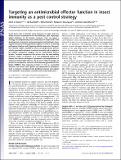| dc.contributor.author | Raman, Rahul | |
| dc.contributor.author | Sasisekharan, Ram | |
| dc.contributor.author | Bachelet, Ido | |
| dc.contributor.author | Bulmera, Mark S. | |
| dc.contributor.author | Rosengaus, Rebeca B. | |
| dc.date.accessioned | 2010-03-12T19:45:53Z | |
| dc.date.available | 2010-03-12T19:45:53Z | |
| dc.date.issued | 2009-04 | |
| dc.date.submitted | 2009-01 | |
| dc.identifier.issn | 1091-6490 | |
| dc.identifier.issn | 0027-8424 | |
| dc.identifier.uri | http://hdl.handle.net/1721.1/52551 | |
| dc.description.abstract | Insect pests such as termites cause damages to crops and man-made structures estimated at over $30 billion per year, imposing a global challenge for the human economy. Here, we report a strategy for compromising insect immunity that might lead to the development of nontoxic, sustainable pest control methods. Gram-negative bacteria binding proteins (GNBPs) are critical for sensing pathogenic infection and triggering effector responses. We report that termite GNBP-2 (tGNBP-2) shows β(1,3)-glucanase effector activity previously unknown in animal immunity and is a pleiotropic pattern recognition receptor and an antimicrobial effector protein. Termites incorporate this protein into the nest building material, where it functions as a nest-embedded sensor that cleaves and releases pathogenic components, priming termites for improved antimicrobial defense. By means of rational design, we present an inexpensive, nontoxic small molecule glycomimetic that blocks tGNBP-2, thus exposing termites in vivo to accelerated infection and death from specific and opportunistic pathogens. Such a molecule, introduced into building materials and agricultural methods, could protect valuable assets from insect pests. | en |
| dc.language.iso | en_US | |
| dc.publisher | United States National Academy of Sciences | en |
| dc.relation.isversionof | http://dx.doi.org/10.1073/pnas.0904063106 | en |
| dc.rights | Article is made available in accordance with the publisher's policy and may be subject to US copyright law. Please refer to the publisher's site for terms of use. | en |
| dc.source | PNAS | en |
| dc.title | Targeting an antimicrobial effector function in insect immunity as a pest control strategy | en |
| dc.type | Article | en |
| dc.identifier.citation | Bulmer, Mark S et al. “Targeting an antimicrobial effector function in insect immunity as a pest control strategy.” Proceedings of the National Academy of Sciences 106.31 (2009): 12652-12657. © 2010 National Academy of Sciences | en |
| dc.contributor.department | Harvard University--MIT Division of Health Sciences and Technology | en_US |
| dc.contributor.approver | Sasisekharan, Ram | |
| dc.contributor.mitauthor | Raman, Rahul | |
| dc.contributor.mitauthor | Sasisekharan, Ram | |
| dc.contributor.mitauthor | Bachelet, Ido | |
| dc.relation.journal | Proceedings of the National Academy of Sciences of the United States of America | en |
| dc.eprint.version | Final published version | en |
| dc.type.uri | http://purl.org/eprint/type/JournalArticle | en |
| eprint.status | http://purl.org/eprint/status/PeerReviewed | en |
| dspace.orderedauthors | Bulmer, M. S.; Bachelet, I.; Raman, R.; Rosengaus, R. B.; Sasisekharan, R. | en |
| dc.identifier.orcid | https://orcid.org/0000-0002-2085-7840 | |
| mit.license | PUBLISHER_POLICY | en |
| mit.metadata.status | Complete | |
